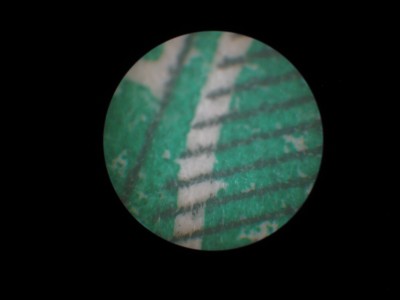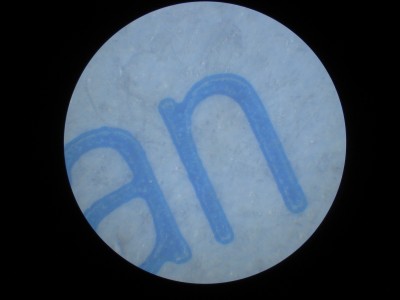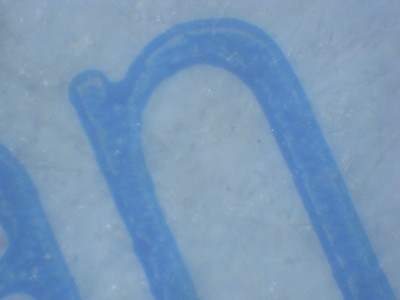I recall burning three or four weeks of a sabbatical getting Saccade.com on the air with Wordpress. So much tweaking…
From my home office: first picture through my microscope
As you might have guessed, I’m a “collector”. Not of anything in particular, but of anything that interests me even vaguely. A few years ago, I bought an old Zeiss Jena laboratory microscope at a swap meet for (if memory serves) around $50. It’s a very nice, heavy microscope and included a pair of Zeiss eyepieces (7x and 10x) and a pair of objectives (10x and 40x). I hadn’t done much with it, but recently I’ve begun to think of fun things that I might do with it, so I dusted it off. Of course, to share pictures of what I see, I’d need to be able to take a photograph through it, so the first order of the day would be to see what I could do with my little Canon SD1100 (a small point-and-shoot camera). Since I didn’t have any microscope slides, I just clamped a dollar bill onto the stage. I installed the 10x objective with a 7x eyepiece, roughly aimed an led flashlight at the mirror, and clicked this picture:
Not bad at all. The image isn’t very well focused because, well, it isn’t very well focused, and because the dollar wasn’t clamped flat, so bits of it are in focus and out of focus, but it’s very promising. I need to setup a good light source and get some slides. Stay tuned, I have something in mind.
Addendum: I found a plastic container that had some small writing on it, which was a tiny bit flatter and setup my camera. I tried zooming in to get rid of the round vignette around the image, and shot these two pictures. Looks like this will work just great. I need to mock up a little mount to hold the camera, and work on getting a better light source, and then some slides and cover slips (already on order) and then… some slightly more interesting pictures hopefully.
Comments
Comment from andre
Time 6/6/2010 at 10:57 am
i came up with a cunning method to generate 3-D video, two B/W video cameras mounted at slight angles on a pair of lenses, feeding an MC1377 and with a LM1881 and video switch with the odd/even output connected across the crystal of one of the cameras.
this allows both cameras to synchronise to a single stream which wouldn’t be possible otherwise.
Pingback from Latest First Microscope news – The Dutch Lead the Invention of the First Compound Microscope
Time 6/15/2010 at 8:12 pm
[…] brainwagon » Blog Archive » From my home office: first picture … […]
Comment from nikoncamera
Time 7/9/2010 at 6:28 am
This is completely true, thanks for making my evening just a little more tolerant.



Comment from Søren
Time 5/27/2010 at 10:01 pm
My father is a pathologist in SLO. A few years ago he almost purchased a Nikon SLR mount for his microsocope. Then he realized he could get photos that were perfectly acceptable for lecturing and print with a little autofocus point and shoot held up to the eyepiece.